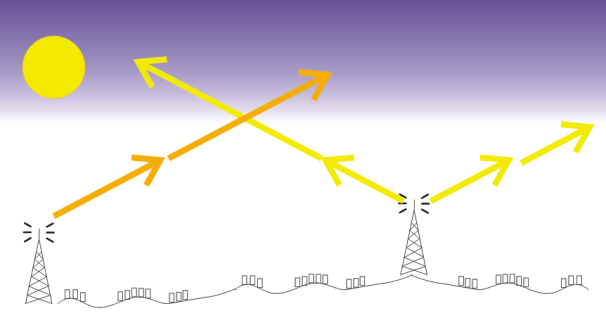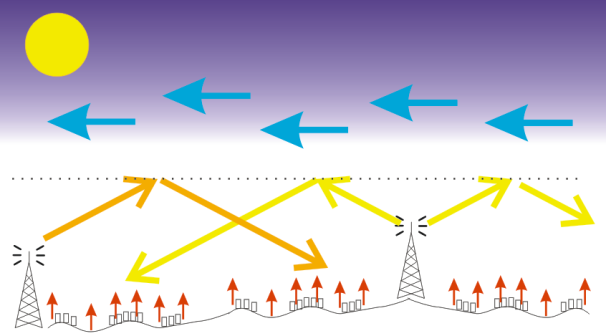What is the Inversion Effect and why does it effect my Freeview TV reception?
 Brian Butterworth published on UK Free TV
Brian Butterworth published on UK Free TV Under normal circumstances, the signals from each television transmitter can only be received by those homes and businesses that have aerials that have a direct line-of-sight to the transmitter.
(The Inversion Effect is also known as "Tropospheric Ducting")

The part of the signal from the transmitter that is directed upwards simply escapes into space and are lost.
When there is high atmospheric pressure (Met Office - Surface pressure charts) as the sun heats up the ground the warm air gets trapped underneath the colder air higher up. At the point where the warm air gets trapped under the cold air this creates a layer that is, in effect, a mirror for the television signals.

This means that signals that would otherwise be impossible to receive can suddenly effect your television reception.
The digital television signal uses a format called COFDM (coded orthogonal frequency division multiplexing) and this incorporates the ability to ignore reflected digital signals.
However, analogue television signals did not co-operate with each other and the picture quality is reduced. The very weak digital signals that were used before digital switchover for Freeview were badly effected by interference from reflected signals from adjacent analogue transmissions.
I recommend you look at the Tropospheric Ducting Forecast for VHF and UHF Radio and TV page for a current forecast - yellow, orange, red, and pink indicate that conditions are perfect for the effects listed above.
Links to current pressure data
John Illy: There is the power of the transmission; that is the strength of the signal as it leaves the transmitter. And there is the strength of the signal at any particular location.
If the signal that you are trying to receive at a particular location is "low", then it will be more susceptible to interference than one which is "high".
The higher the power of the transmitter, the higher the level of the signal will be at your location.
The sentence that you've quoted explains that the "low" level digital signal is more affected by "high" strength analogue [than if the local digital signal had been of "high" strength].
An analogy is if you talk loudly (the level of your voice is "high") then the reception of your voice will be less susceptible to interference from those talking around you. If you talk quitely (your voice at "low" level), then the person listening to your voice is *more likely* to suffer interference due to the person speaking at "high" level nearby.
The receiver of your conversation is hearing all voices in the area, and in order to hear you, yours needs to be at the receiver's ears.
The signal going into the receiver's ears is therefore the sum of all voices in the area, each having travelled to that location (and therefore lost some of their volume). The same goes for reception of electromagnetic (radio) signals.
| link to this comment |
John Illy: My last but one paragraph should say: "The receiver of your conversation is hearing all voices in the area, and in order to hear you, yours needs to be *highest* at the receiver's ears."
| link to this comment |
11:15 PM
The strength of signal at our end is pretty high. I seem to have solved our problem by plugging in an old indoor aerial. I suspect that the new rooftop one is too good and was picking up all sorts of rubbish from a long way away.
| link to this comment |
10:34 AM
COFDM doesn't incorporate any ability to discriminate against other digital broadcasts on the same channel, only multipath reception of the same signal.
The unwanted transmission merely adds noise to the wanted one. Once the signal to noise ratio drops far enough, reception will be lost.
The problems caused by high pressure weather won't be going away with DSO.
| link to this comment |
11:22 PM
Corby
Lets make things look professional. PLEASE PLEASE as Steve P says, change the title to the correct "how will this AFFECT......". Apart from that, thanks for all your efforts Brian.
| link to this comment |
Mike's: mapM's Freeview map terrainM's terrain plot wavesM's frequency data M's Freeview Detailed Coverage
7:02 PM
Littlehampton
Today 05/04/2012 the reception in my area has been awful. I live in a sheltered scheme and I am the only resident using Freeveiw and all day today I have had pixilation except on the HD channels.
I have tried re-tuning but to no avail, what is going on.
| link to this comment |
Jax01's: mapJ's Freeview map terrainJ's terrain plot wavesJ's frequency data J's Freeview Detailed Coverage
6:26 PM
That should be "why does it affect..." (not "effect"). "To effect" is to cause, to bring into being - it does not mean "to influence".
| link to this comment |
7:58 AM
I had the digital switch over at the end of May but I'm still being affected during the hot weather! I loose channels, get picture break up and just general annoyance. Our aerial is fine, and we keep retuning the boxes but nothing seems to help. Seems to me that the so called 'boosted' signal was all talk!
| link to this comment |
8:32 PM
Chatham
Hi,
My Mother is situtated about halfway down the valley in Walderslade. Has a roof-moun ted aerial and experiences picture break-up on a Samsung HDD/DVD recorder. When recording, it not only breaks up but locks up, stopping the recording. The Samsung TV is not affected so badly. The BBC FAQs suggest that the issue is co-channel interference for which there is no cure. However, posts on here suggest that an attenuator might help. Is that the case? Where would I find one? Is manual tuning the way to go first? Many thanks!
| link to this comment |
Mike's: mapM's Freeview map terrainM's terrain plot wavesM's frequency data M's Freeview Detailed Coverage
5:58 PM
We have high pressure in Westbrook margate Kent time 17:30 and have lost all picture quality on all bbc tv stations with no picture.
| link to this comment |
